Hao Xie
Accurate and thermodynamically consistent hydrogen equation of state for planetary modeling with flow matching
Jan 17, 2025Abstract:Accurate determination of the equation of state of dense hydrogen is essential for understanding gas giants. Currently, there is still no consensus on methods for calculating its entropy, which play a fundamental role and can result in qualitatively different predictions for Jupiter's interior. Here, we investigate various aspects of entropy calculation for dense hydrogen based on ab initio molecular dynamics simulations. Specifically, we employ the recently developed flow matching method to validate the accuracy of the traditional thermodynamic integration approach. We then clearly identify pitfalls in previous attempts and propose a reliable framework for constructing the hydrogen equation of state, which is accurate and thermodynamically consistent across a wide range of temperature and pressure conditions. This allows us to conclusively address the long-standing discrepancies in Jupiter's adiabat among earlier studies, demonstrating the potential of our approach for providing reliable equations of state of diverse materials.
Frequency-Aware Guidance for Blind Image Restoration via Diffusion Models
Nov 19, 2024



Abstract:Blind image restoration remains a significant challenge in low-level vision tasks. Recently, denoising diffusion models have shown remarkable performance in image synthesis. Guided diffusion models, leveraging the potent generative priors of pre-trained models along with a differential guidance loss, have achieved promising results in blind image restoration. However, these models typically consider data consistency solely in the spatial domain, often resulting in distorted image content. In this paper, we propose a novel frequency-aware guidance loss that can be integrated into various diffusion models in a plug-and-play manner. Our proposed guidance loss, based on 2D discrete wavelet transform, simultaneously enforces content consistency in both the spatial and frequency domains. Experimental results demonstrate the effectiveness of our method in three blind restoration tasks: blind image deblurring, imaging through turbulence, and blind restoration for multiple degradations. Notably, our method achieves a significant improvement in PSNR score, with a remarkable enhancement of 3.72\,dB in image deblurring. Moreover, our method exhibits superior capability in generating images with rich details and reduced distortion, leading to the best visual quality.
Towards Multi-View Consistent Style Transfer with One-Step Diffusion via Vision Conditioning
Nov 15, 2024



Abstract:The stylization of 3D scenes is an increasingly attractive topic in 3D vision. Although image style transfer has been extensively researched with promising results, directly applying 2D style transfer methods to 3D scenes often fails to preserve the structural and multi-view properties of 3D environments, resulting in unpleasant distortions in images from different viewpoints. To address these issues, we leverage the remarkable generative prior of diffusion-based models and propose a novel style transfer method, OSDiffST, based on a pre-trained one-step diffusion model (i.e., SD-Turbo) for rendering diverse styles in multi-view images of 3D scenes. To efficiently adapt the pre-trained model for multi-view style transfer on small datasets, we introduce a vision condition module to extract style information from the reference style image to serve as conditional input for the diffusion model and employ LoRA in diffusion model for adaptation. Additionally, we consider color distribution alignment and structural similarity between the stylized and content images using two specific loss functions. As a result, our method effectively preserves the structural information and multi-view consistency in stylized images without any 3D information. Experiments show that our method surpasses other promising style transfer methods in synthesizing various styles for multi-view images of 3D scenes. Stylized images from different viewpoints generated by our method achieve superior visual quality, with better structural integrity and less distortion. The source code is available at https://github.com/YushenZuo/OSDiffST.
Privacy Amplification by Iteration for ADMM with (Strongly) Convex Objective Functions
Dec 14, 2023


Abstract:We examine a private ADMM variant for (strongly) convex objectives which is a primal-dual iterative method. Each iteration has a user with a private function used to update the primal variable, masked by Gaussian noise for local privacy, without directly adding noise to the dual variable. Privacy amplification by iteration explores if noises from later iterations can enhance the privacy guarantee when releasing final variables after the last iteration. Cyffers et al. [ICML 2023] explored privacy amplification by iteration for the proximal ADMM variant, where a user's entire private function is accessed and noise is added to the primal variable. In contrast, we examine a private ADMM variant requiring just one gradient access to a user's function, but both primal and dual variables must be passed between successive iterations. To apply Balle et al.'s [NeurIPS 2019] coupling framework to the gradient ADMM variant, we tackle technical challenges with novel ideas. First, we address the non-expansive mapping issue in ADMM iterations by using a customized norm. Second, because the dual variables are not masked with any noise directly, their privacy guarantees are achieved by treating two consecutive noisy ADMM iterations as a Markov operator. Our main result is that the privacy guarantee for the gradient ADMM variant can be amplified proportionally to the number of iterations. For strongly convex objective functions, this amplification exponentially increases with the number of iterations. These amplification results align with the previously studied special case of stochastic gradient descent.
Efficient Numerical Algorithm for Large-Scale Damped Natural Gradient Descent
Oct 26, 2023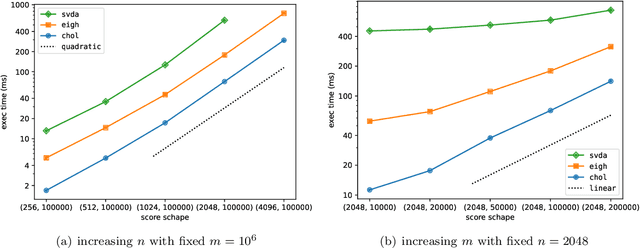

Abstract:We propose a new algorithm for efficiently solving the damped Fisher matrix in large-scale scenarios where the number of parameters significantly exceeds the number of available samples. This problem is fundamental for natural gradient descent and stochastic reconfiguration. Our algorithm is based on Cholesky decomposition and is generally applicable. Benchmark results show that the algorithm is significantly faster than existing methods.
Enhancing Spectrum Sensing via Reconfigurable Intelligent Surfaces: Passive or Active Sensing and How Many Reflecting Elements are Needed?
Jun 24, 2023Abstract:Cognitive radio has been proposed to alleviate the scarcity of available spectrum. However, sensing performance is quite poor due to the low sensing signal-to-noise ratio. Fortunately, reconfigurable intelligent surface (RIS)-aided spectrum sensing can effectively tackle the above challenge due to its high array gain. Nevertheless, the traditional passive RIS suffers from the ``double fading'' effect, which severely restricts the performance of passive RIS-aided spectrum sensing. To this end, we introduce the active RIS into spectrum sensing and respectively formulate two optimization problems for the passive RIS and the active RIS to maximize the detection probability. In light of the intractability of the formulated problems, we develop a one-stage optimization algorithm with inner approximation and a two-stage optimization algorithm with a bisection method to obtain sub-optimal solutions, and apply the Rayleigh quotient to obtain the upper and lower bounds of the detection probability. Furthermore, in order to gain more insight into the impact of the RIS on spectrum sensing, we respectively investigate the number configuration for passive RIS and active RIS and analyze how many reflecting elements are needed to achieve the detection probability close to 1. Simulation results verify the effectiveness of the proposed algorithms.
Computation-Efficient Backscatter-Blessed MEC with User Reciprocity
May 10, 2023


Abstract:This letter proposes a new user cooperative offloading protocol called user reciprocity in backscatter communication (BackCom)-aided mobile edge computing systems with efficient computation, whose quintessence is that each user can switch alternately between the active or the BackCom mode in different slots, and one user works in the active mode and the other user works in the BackCom mode in each time slot. In particular, the user in the BackCom mode can always use the signal transmitted by the user in the active mode for more data transmission in a spectrum-sharing manner. To evaluate the proposed protocol, a computation efficiency (CE) maximization-based optimization problem is formulated by jointly power control, time scheduling, reflection coefficient adjustment, and computing frequency allocation, while satisfying various physical constraints on the maximum energy budget, the computing frequency threshold, the minimum computed bits, and harvested energy threshold. To solve this non-convex problem, Dinkelbach's method and quadratic transform are first employed to transform the complex fractional forms into linear ones. Then, an iterative algorithm is designed by decomposing the resulting problem to obtain the suboptimal solution. The closed-form solutions for the transmit power, the RC, and the local computing frequency are provided for more insights. Besides, the analytical performance gain with the reciprocal mode is also derived. Simulation results demonstrate that the proposed scheme outperforms benchmark schemes regarding the CE.
To Reflect or Not To Reflect: On-Off Control and Number Configuration for Reflecting Elements in RIS-Aided Wireless Systems
Apr 26, 2023



Abstract:Reconfigurable intelligent surface (RIS) has been regarded as a promising technique due to its high array gain and low power. However, the traditional passive RIS suffers from the ``double fading'' effect, which has restricted the performance of passive RIS-aided communications. Fortunately, active RIS can alleviate this problem since it can adjust the phase shift and amplify the received signal simultaneously. Nevertheless, a high beamforming gain often requires a number of reflecting elements, which leads to non-negligible power consumption, especially for the active RIS. Thus, one challenge is how to improve the scalability of the RIS and the energy efficiency. Different from the existing works where all reflecting elements are activated, we propose a novel element on-off mechanism where reflecting elements can be flexibly activated and deactivated. Two different optimization problems for passive RIS and active RIS are formulated by maximizing the total energy efficiency. We develop two different alternating optimization-based iterative algorithms to obtain sub-optimal solutions. Furthermore, we consider special cases involving rate maximization problems for given the same total power budget, and respectively analyze the number configuration for passive RIS and active RIS. Simulation results verify that reflecting elements under the proposed algorithms can be flexibly activated and deactivated.
Exploring Hybrid Active-Passive RIS-Aided MEC Systems: From the Mode-Switching Perspective
Dec 16, 2022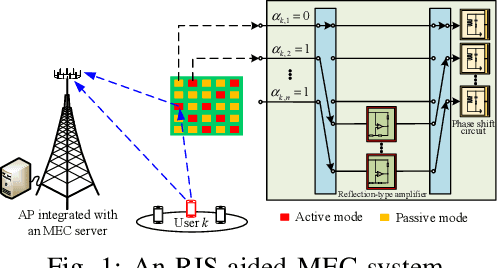
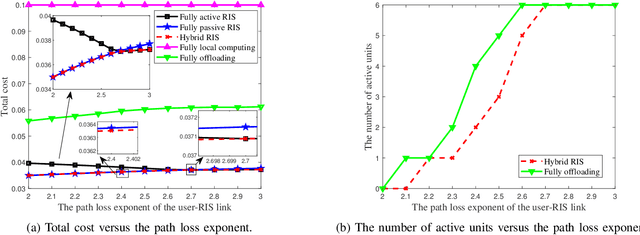
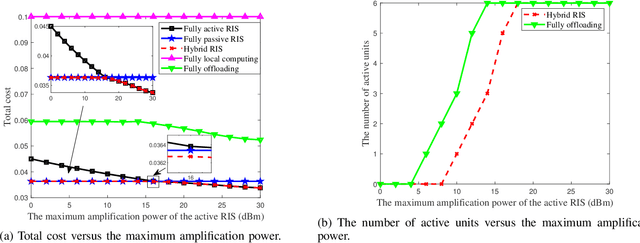
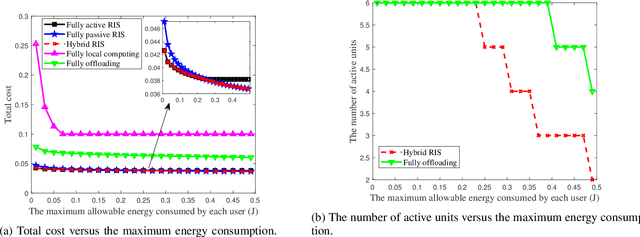
Abstract:Mobile edge computing (MEC) has been regarded as a promising technique to support latencysensitivity and computation-intensive serves. However, the low offloading rate caused by the random channel fading characteristic becomes a major bottleneck in restricting the performance of the MEC. Fortunately, reconfigurable intelligent surface (RIS) can alleviate this problem since it can boost both the spectrum- and energy- efficiency. Different from the existing works adopting either fully active or fully passive RIS, we propose a novel hybrid RIS in which reflecting units can flexibly switch between active and passive modes. To achieve a tradeoff between the latency and energy consumption, an optimization problem is formulated by minimizing the total cost. In light of the intractability of the problem, we develop an alternating optimization-based iterative algorithm by combining the successive convex approximation method, the variable substitution, and the singular value decomposition (SVD) to obtain sub-optimal solutions. Furthermore, in order to gain more insight into the problem, we consider two special cases involving a latency minimization problem and an energy consumption minimization problem, and respectively analyze the tradeoff between the number of active and passive units. Simulation results verify that the proposed algorithm can achieve flexible mode switching and significantly outperforms existing algorithms.
Gain without Pain: Recycling Reflected Energy from Wireless Powered RIS-aided Communications
Sep 27, 2022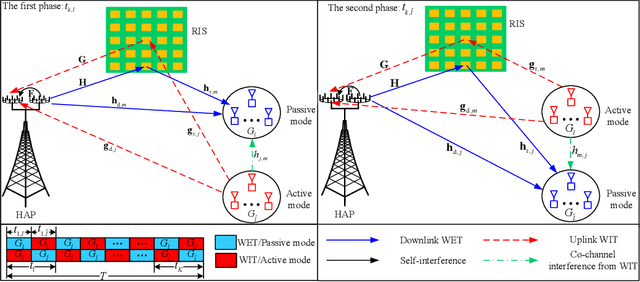
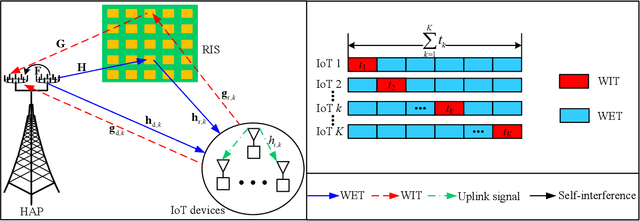
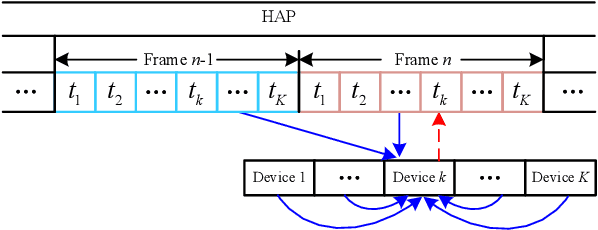
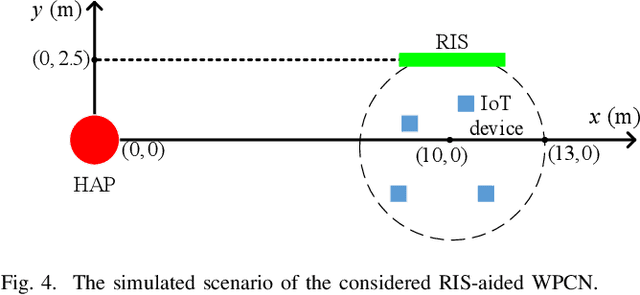
Abstract:In this paper, we investigate and analyze energy recycling for a reconfigurable intelligent surface (RIS)-aided wireless-powered communication network. As opposed to the existing works where the energy harvested by Internet of things (IoT) devices only come from the power station, IoT devices are also allowed to recycle energy from other IoT devices. In particular, we propose group switching- and user switching-based protocols with time-division multiple access to evaluate the impact of energy recycling on system performance. Two different optimization problems are respectively formulated for maximizing the sum throughput by jointly optimizing the energy beamforming vectors, the transmit power, the transmission time, the receive beamforming vectors, the grouping factors, and the phase-shift matrices, where the constraints of the minimum throughput, the harvested energy, the maximum transmit power, the phase shift, the grouping, and the time allocation are taken into account. In light of the intractability of the above problems, we respectively develop two alternating optimization-based iterative algorithms by combining the successive convex approximation method and the penalty-based method to obtain corresponding sub-optimal solutions. Simulation results verify that the energy recycling-based mechanism can assist in enhancing the performance of IoT devices in terms of energy harvesting and information transmission. Besides, we also verify that the group switching-based algorithm can improve more sum throughput of IoT devices, and the user switching-based algorithm can harvest more energy.
 Add to Chrome
Add to Chrome Add to Firefox
Add to Firefox Add to Edge
Add to Edge